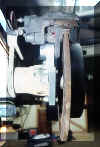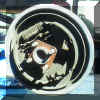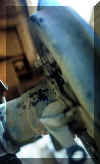Spidertrax provides really good instructions, so we're not
going to get in to detailed installation instructions here. There are additional
details and notes as well as some pictures to provide you with additional
information.
Tools
| Rags | Torque wrench |
| Slide hammer or axle puller | Socket wrench |
| Suzuki's Samurai Maintenance Manual (You DO have one by now, right?) | Light grease and gear oil |
| Hack saw, cut-off tool or reciprocating saw | Assorted flare wrenches |
| Assorted metric and standard sockets | Assorted metric and standard box/open-end wrenches |
| Scrounged, used or new Samurai front brake calipers | Scrounged, used or new Samurai front brake discs (rotors) |
| Scrounged, used or new Samurai front brake flex lines | New brake pads |
Preparation
This is the part you're probably going to hate.
Assembly
 |
Slip the caliper brackets over the axle stub. The engraved Spidertrax lettering faces inboard. Bolt the bracket in place using the hardware provided with the kit. Torque fasteners to the specs given in the Spidertrax instructions. |
 |
Press the provided studs into the new wheel adapters. There is no "right side" for the adapters, the studs can be inserted from either side. Mount the adapters on the axle end using the original fasteners. Torque fasteners to the specs given in the Spidertrax instructions. |
 |
Slip your scrounged, used or new rotors over the studs on the adapter plates. Back the caliper's pistons out all the way and install new brake pads. Slip the caliper over the rotor and in place on the mounting bracket. Torque the caliper mounting bolts to the specs given in the Spidertrax instructions. |
 |
You're almost done! This is what things should look like at this point. |
 |
Attach the flexible brake lines to the rigid lines from Spidertrax Brake Line Kit (or your own home-brew lines) on the axle. |
| Remount the wheels and torque the lugs to spec. | |
| If you've accomplished everything else (brake lines and proportioning valve installation) at this point, be sure the system is filled and then bleed the brakes. I used synthetic brake fluid when refilling, as I figured the little added expense was worth it with discs all around. |
Finishing Up
Test! Use Spidertrax recommendations and test, test, test until you're satisfied that your new brakes are safe. The last thing you want to do is find some overlooked problem when you're attempting a panic stop from 70 mph on the freeway. It may be the last thing you ever do.
If you can't get things right, carefully drive to a brake specialist and have them make it right.
Follow @Off-Road








 Your Privacy Choices
Your Privacy Choices